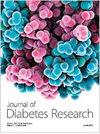Does Treatment with Sodium-Glucose Cotransporter-2 Inhibitors Affect Adherence to International Society Criteria for Diabetic Ketoacidosis in Adult Patients with Type 2 Diabetes? A Retrospective Cohort Analysis
IF 3.4
3区 医学
Q2 ENDOCRINOLOGY & METABOLISM
引用次数: 0
Abstract
Objective(s). Diabetic ketoacidosis (DKA) is a rare but well-known complication of sodium-glucose transporter inhibitor (SGLT2i) treatment in patients with type 2 diabetes. The physiological effects of SGLT2i are such that hyperglycaemia and ketonuria are no longer reliable diagnostic tools in patients treated with this class of medication. Diagnostic criteria for DKA varies between major society guidelines. The Joint British Diabetes Society (JBDS) and American Association of Clinical Endocrinology/American College of Endocrinology (AACE/ACE) have recently made changes to their diagnostic criteria to account for the effects of SGTL2i. This study sought to investigate whether treatment with SGLT2i might result in overdiagnosis of DKA and less adherence to the international diagnostic guidelines in hospitalised patients with type 2 diabetes treated with SGLT2i. Additionally, the demographics and clinical characteristics of patients with type 2 diabetes presenting with DKA were compared based on their treatment with SGLT2i at the time of diagnosis. Design. Retrospective observational study. Setting. Inpatients at two teaching hospitals in Queensland, Australia. Primary Outcome Measure(s). The number of patients meeting the Joint British Diabetes Society (JBDS) and American Association of Clinical Endocrinology/American College of Endocrinology (AACE/ACE) diagnostic criteria for DKA. Patients were divided into two groups by treatment with SGLT2i at the time of diagnosis. Participants. Adult patients (>18 years old) with type 2 diabetes diagnosed with DKA from April 2015 to January 2022. Patients without type 2 diabetes were excluded. Results. One hundred and sixty-five patients were included in this study—comprising 94 patients in the SGLT2i cohort and 70 in the non-SGLT2i cohort. A significantly smaller proportion of patients in the SGLT2i vs. non-SGLT2i cohorts met both JBDS (56% vs. 72%, ) and AACE/ACE (63% vs. 82%, ) criteria for diagnosis of DKA. Conclusion. Patients with type 2 diabetes treated with SGLT2i may be more likely to be diagnosed with DKA despite not meeting the criteria. Despite recent adjustments to account the physiological effects of SGLT2i, significant variation in criteria between major society guidelines presents ongoing challenges to clinicians. The proportion of patients diagnosed using both JDBS and AACE/ACE were comparable, suggesting a reasonable degree of agreement.钠-葡萄糖共转运体-2 抑制剂的治疗会影响 2 型糖尿病成人患者遵守国际糖尿病酮症酸中毒协会标准吗?回顾性队列分析
目的:糖尿病酮症酸中毒(DKA)糖尿病酮症酸中毒(DKA)是一种罕见但众所周知的 2 型糖尿病患者钠-葡萄糖转运体抑制剂(SGLT2i)治疗并发症。SGLT2i 的生理效应使得高血糖和酮尿不再是接受该类药物治疗的患者的可靠诊断工具。各主要学会的指南对 DKA 的诊断标准不尽相同。英国糖尿病学会(JBDS)和美国临床内分泌学会/美国内分泌学会(AACE/ACE)最近对其诊断标准进行了修改,以考虑 SGTL2i 的影响。本研究旨在探讨在接受 SGLT2i 治疗的住院 2 型糖尿病患者中,SGLT2i 治疗是否会导致 DKA 过度诊断以及对国际诊断指南的遵守程度降低。此外,根据诊断时接受 SGLT2i 治疗的情况,比较了出现 DKA 的 2 型糖尿病患者的人口统计学和临床特征。设计。回顾性观察研究。研究地点澳大利亚昆士兰州两家教学医院的住院患者。主要结果指标。符合英国糖尿病学会(JBDS)和美国临床内分泌协会/美国内分泌学院(AACE/ACE)联合诊断标准的 DKA 患者人数。根据诊断时接受的 SGLT2i 治疗将患者分为两组。参与者。2015年4月至2022年1月期间确诊为DKA的成年2型糖尿病患者(>18岁)。未患 2 型糖尿病的患者除外。结果。本研究共纳入165名患者,其中包括94名SGLT2i队列患者和70名非SGLT2i队列患者。符合 JBDS(56% 对 72%,)和 AACE/ACE (63% 对 82%,)诊断标准的 SGLT2i 和非 SGLT2i 患者比例明显较低。结论接受 SGLT2i 治疗的 2 型糖尿病患者尽管不符合 DKA 诊断标准,但却更有可能被诊断为 DKA。尽管最近根据 SGLT2i 的生理效应进行了调整,但各主要学会指南之间的标准仍存在显著差异,这给临床医生带来了持续的挑战。使用 JDBS 和 AACE/ACE 诊断的患者比例相当,这表明两者在一定程度上是一致的。
本文章由计算机程序翻译,如有差异,请以英文原文为准。
求助全文
约1分钟内获得全文
求助全文
来源期刊

Journal of Diabetes Research
ENDOCRINOLOGY & METABOLISM-MEDICINE, RESEARCH & EXPERIMENTAL
CiteScore
8.40
自引率
2.30%
发文量
152
审稿时长
14 weeks
期刊介绍:
Journal of Diabetes Research is a peer-reviewed, Open Access journal that publishes research articles, review articles, and clinical studies related to type 1 and type 2 diabetes. The journal welcomes submissions focusing on the epidemiology, etiology, pathogenesis, management, and prevention of diabetes, as well as associated complications, such as diabetic retinopathy, neuropathy and nephropathy.
 求助内容:
求助内容: 应助结果提醒方式:
应助结果提醒方式:


